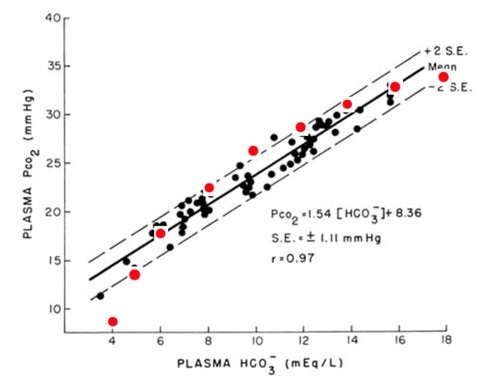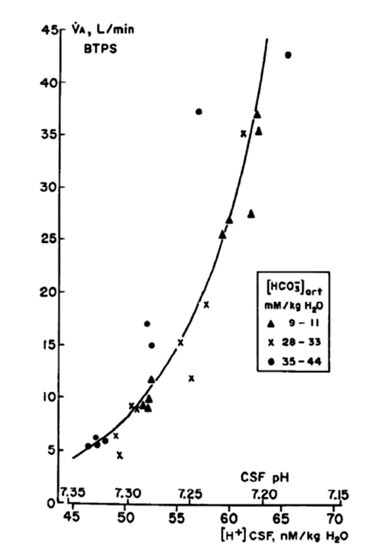The Two-Digit Rule and Winter’s Formula
 Monday, July 10, 2023 at 1:25PM
Monday, July 10, 2023 at 1:25PM To the Editor,
I recently wondered, “How does the “Two-digit rule” for determining the adequacy of respiratory compensation for metabolic acidosis relate to Winter’s formula?” Many clinicians were taught this rule-of-thumb: the last two digits of the pH (those visible if you hold your thumb over the “7”) should provide an approximation of pCO2 (in mm Hg) in the presence of normal respiratory compensation. Although Winter’s formula is easy to remember and perform, the Two-digit rule is even easier. Winter’s formula and the Two-digit rule have both been derived empirically from clinical data (1,2). But the reason the Two-digit rule should work has never, to our knowledge, been adequately explained. We wondered how the two rules were related.
We began with serum HCO3 values ranging from 4 -18 mmol/L and used them to calculate the corresponding predicted pCO2 values using Winter’s formula (3). Next, we used the Henderson-Hasselbalch equation to calculate the corresponding pH for each [HCO3-]/pCO2 pair and used the Two-digit rule to re-calculate the corresponding predicted pCO2. The predicted compensatory pCO2 calculated by the Two-digit rule and Winter’s formula were then compared.
Table 1. Comparison of predicted compensatory respiratory response to metabolic acidosis by Winter’s formula and the Two-digit rule. Results of the Two-digit rule in red font fall outside the 95% standard error range of Winter’s formula. (Click here to view Table 1 in a separate, enlarged window)

Estimates of pCO2 by the Two-digit rule were then superimposed over Winter’s original graphical data, from which the Winter’s formula was derived (1). See below.
 Figure 1. Predicted pCO2 by the Two-digit rule (in red font) superimposed over the original graphic used to derive Winter’s formula (1). (Click here to view Figure 1 in a separate, enlarged window)
Figure 1. Predicted pCO2 by the Two-digit rule (in red font) superimposed over the original graphic used to derive Winter’s formula (1). (Click here to view Figure 1 in a separate, enlarged window)
Note that the Two-digit rule provides pCO2 estimates within two standard errors (+/- 2 mm Hg) of Winter’s formula, for most [HCO3-] values ranging from 5-18 mmol/L. At a HCO3 of 10 mmol/L, the Two-digit rule overestimates pCO2 by 1mmHg compared to Winter’s formula. At HCO3 above 18 mmol/L and below 5 mmol/L, the Two-digit rule underestimates pCO2 compared to Winter’s.
The apparently linear relationship between pH (the negative base-ten logarithm of [H+]) and related partial pressure of pCO2 in mm Hg is explained by the three relationships that link their association.
1) pH has a negative logarithmic association with [H+]. As most who have used the simplified form of the Henderson-Hasselbalch equation ([H+] = 24*pCO2/HCO3) will remember, this relationship is conveniently approximately linear over the narrow range of physiological pH values, such that [H+] values of 30, 40, 50 and 60 nmol/L approximately correspond to pHs of 7.50, 7.40, 7.30 and 7.20 respectively. 2) Central chemoreceptors in the ventral medulla (and other locations) respond to increasing brain interstitial [H+] by increasing ventilatory drive in a fashion that is also approximately linear in the physiological range of pH values (3). See figure below. 3) Ventilatory drive is inversely linearly related to pCO2.
(More precisely, PaCO2 = VCO2*K/VALV , where VCO2=the rate of CO2 production, K, is a proportionality constant, and VALV=alveolar minute ventilation (total ventilation – dead space ventilation.)
 Figure 2. The ventilatory response to changes in brain interstitial fluid pH as studied in conscious goats (3). (Click here to view Figure 2 in a separate, enlarged window)
Figure 2. The ventilatory response to changes in brain interstitial fluid pH as studied in conscious goats (3). (Click here to view Figure 2 in a separate, enlarged window)
Therefore, It's not surprising that the last two digits of the pH should have a positive, approximately linear correlation with pCO2. However, the convenience of the correlation (two digits of the pH equaling the pCO2) is purely fortuitous. The Two-digit rule provides a good approximation of the expected compensatory pCO2 as calculated by Winter’s formula for [HCO3-] ranging from 5-18 mmol/L.
Robert Raschke MD
Clinical Professor of Medicine, University of Arizona College of Medicine – Phoenix
Phoenix, AZ USA
References
- Albert MS, Dell RB, Winters RW. Quantitative displacement of acid-base equilibrium in metabolic acidosis. Ann Intern Med. 1967 Feb;66(2):312-22. [CrossRef] [PubMed]
- Fulop M. A guide for predicting arterial CO2 tension in metabolic acidosis. Am J Nephrol. 1997;17(5):421-4. [CrossRef] [PubMed] (This shows empirical derivation of two-digit rule.)
- Fencl V, Miller TB, Pappenheimer JR. Studies on the respiratory response to disturbances of acid-base balance, with deductions concerning the ionic composition of cerebral interstitial fluid. Am J Physiol. 1966 Mar;210(3):459-72. [CrossRef][PubMed] (This shows relationship between resp drive and [H].)

Reader Comments